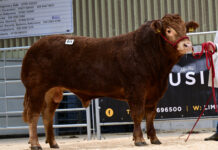Scrotal circumference has been released as an Estimated Breeding Value (EBV) for the first time in UK‐based beef cattle evaluations. Over the last two years, Limousin breeders have been collecting measurements on‐farm to provide a robust bank of records from which the EBV has been developed.
Funded by the Knowledge Transfer Network, with support from the British Limousin Cattle Society, Signet and Egenes (SAC), breeders and ultimately buyers of pedigree Limousin bulls will now have the opportunity to take scrotal size into consideration when making their selections.
“What this means is a further increase in the availability of tools that identify the genetic strengths and weaknesses of breeding stock that directly relate to economic returns,” said Alison Glasgow, breeding specialist with Signet, the national genetic evaluation service for cattle and sheep, which is part of EBLEX.
“There are two main reasons why scrotal circumference is important in beef production. The first is that it is an indicator of male fertility in terms of sperm manufacture and serving capacity. It is widely acknowledged that bulls with genetically larger scrotal sizes are typically more likely to be able to successfully serve numbers of cows within a time‐frame than bulls with genetically smaller scrotal sizes. “The second reason is that it is also an indicator of early sexual maturity in a bull’s daughters. Recording of the onset of puberty can be a difficult thing to manage, but the established link between it and scrotal size mean it can be predicted with much greater ease. Heifers sired by bulls with genetically larger scrotal sizes are typically more likely to mature at a younger age and therefore more likely to be able to hold to first service opportunity.”
The research into, and subsequent development of, this EBV, carried out by Egenes (SAC), has revealed a heritability of 33 per cent. This means 33 per cent of an observation is down to the genes the animal has inherited from its parents, the remaining 66 per cent being influenced by environmental factors, such as management regime. This is considered to be reasonable and is comparable with the heritability of some of the growth and carcase traits. Consequently, relatively quick changes can be made in a herd by identifying and using the most appropriate animals. The economic impact in a commercial herd in terms of a bull being unable to serve its required number of cows, or where heifers do not hold at their early bulling opportunities, can be severe. More worrying is that their effect is often invisible, since it can be difficult to identify the bull as the source of the problem and the natural inclination is to blame other factors more easily identified.
Iain Kerr, chief executive of the British Limousin Cattle Society, said: “By undertaking this work, the Limousin Cattle Society and breeders of pedigree Limousin bulls are providing further support to their customers in sourcing bulls that are suitable for the job expected of them.”
To view this and all other recorded EBVs and the animals they relate to, click on the ‘BASCO’ link from www.limousin.co.uk For further technical guidance go to www.signetfbc.co.uk

















